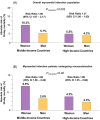Coronary revascularization and sex differences in cardiovascular mortality after myocardial infarction in 12 high and middle-income European countries
- PMID: 38714331
- PMCID: PMC12445642
- DOI: 10.1093/ehjqcco/qcae035
Coronary revascularization and sex differences in cardiovascular mortality after myocardial infarction in 12 high and middle-income European countries
Abstract
Background: Existing data on female sex and excess cardiovascular mortality after myocardial infarction (MI) mostly come from high-income countries (HICs). This study aimed to investigate how sex disparities in treatments and outcomes vary across countries with different income levels.
Methods: Data from the ISACS Archives registry included 22 087 MI patients from 6 HICs and 6 middle-income countries (MICs). MI data were disaggregated by clinical presentation: ST-segment elevation myocardial infarction (STEMI) and non-ST-segment elevation myocardial infarction (NSTEMI). The primary outcome was 30-day mortality.
Results: Among STEMI patients, women in MICs had nearly double the 30-day mortality rate of men [12.4% vs. 5.8%; adjusted risk ratio (RR) 2.30, 95% CI 1.98-2.68]. This difference was less pronounced in HICs (6.8% vs. 5.1%; RR 1.36, 95% CI 1.05-1.75). Despite more frequent treatments and timely revascularization in MICs, sex-based mortality differences persisted even after revascularization (8.0% vs. 4.1%; RR 2.05, 95% CI, 1.68-2.50 in MICs and 5.6% vs. 2.6%; RR 2.17, 95% CI, 1.48-3.18) in HICs. Additionally, women from MICs had higher diabetes rates compared to HICs (31.8% vs. 25.1%, standardized difference = 0.15). NSTEMI outcomes were relatively similar between sexes and income groups.
Conclusions: Sex disparities in mortality rates following STEMI are more pronounced in MICs compared to HICs. These disparities cannot be solely attributed to sex-related inequities in revascularization. Variations in mortality may also be influenced by sex differences in socioeconomic factors and baseline comorbidities.
Keywords: Middle-income countries; Myocardial infarction; Outcomes; Sex differences.
© The Author(s) 2024. Published by Oxford University Press on behalf of the European Society of Cardiology.
Figures




Comment in
-
Women with acute and chronic myocardial ischaemia have worse early results after PTCA and CABG, but better 1-year results.Eur Heart J Qual Care Clin Outcomes. 2024 Dec 19;10(8):763. doi: 10.1093/ehjqcco/qcae046. Eur Heart J Qual Care Clin Outcomes. 2024. PMID: 38871670 No abstract available.
References
-
- Walli-Attaei M, Joseph P, Rosengren A, Chow CK, Rangarajan S, Lear SA et al. Variations between women and men in risk factors, treatments, cardiovascular disease incidence, and death in 27 high-income, middle-income, and low-income countries (PURE): a prospective cohort study. Lancet North Am Ed 2020;396:97–109. - PubMed
-
- Kerola AM, Palomaki A, Rautava P, Kyto V. Less revascularization in young women but impaired long-term outcomes in young men after myocardial infarction. Eur J Prev Cardiol 2022;29:1437–1445. - PubMed
-
- Bugiardini R, Badimon L. The International Survey of Acute Coronary Syndromes in Transitional Countries (ISACS-TC): 2010-2015. Int J Cardiol 2016;217:S1–S6. - PubMed
-
- Thygesen K, Alpert JS, Jaffe AS, Simoons ML, Chaitman BR, White HD et al. Third universal definition of myocardial infarction. Circulation 2012;126:2020–2035. - PubMed
Publication types
MeSH terms
LinkOut - more resources
Full Text Sources
Medical

